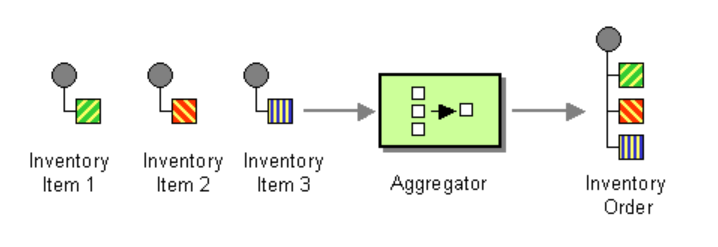What are EIPs
Apache Camel’s Enterprise Integration Patterns (EIP) are an essential part of its routing and mediation engine, providing a set of common patterns for connecting and integrating different systems and applications. EIPs are pre-defined solutions for common integration problems and are designed to be used as building blocks to create complex integration scenarios. See here for a list of the support EIPs in camel.
Typical use cases of EIP
1. Content-Based Routing
Here is a picture of content based routing. It is the same semantic like a a „if, else if else“ in java

The router decides, where to route. The input could be a XML-file and the router chooses based on an XPath, where to route the message. The destinations are either Widget Inventory or Gadget Inventory
2. Message Translator – Mapping
The Message Translator pattern is used to convert messages from one format to another. This pattern is commonly used in scenarios where systems or applications have different message formats that need to be converted before being processed. Apache Camel provides a number of built-in translators, including the Format Translator, which converts messages between different formats such as XML and JSON, and the Content Enricher, which adds information to messages before they are sent to their destination.

3. Message Filter
Similar to the content-based-router the message filters the message. But here you only route if the message fulfills the message. You can easily implement your own predicates in a java bean, or just via the fluent API of camel methods like XPath, or JSON path to easily translate your logic to the route

As you can see, you get three incoming messages, but only one message fulfills the predicate of the content-filter
4. Message Splitter
The Message Splitter pattern is used to split a single message into multiple messages. This pattern is commonly used in scenarios where a single message needs to be processed as multiple messages. Apache Camel provides a number of built-in splitters, including the Tokenizer Splitter, which splits messages based on a delimiter, and the Xml Tokenizer Splitter, which splits messages based on an XML element.
Here you split the incoming message into multiple messages.

5. Message Aggregator
The Message Aggregator is the opposite of the Message Splitter. This pattern is commonly used in scenarios where multiple messages need to be combined into a single message for processing. Apache Camel provides a number of built-in aggregators, including the Timeout Aggregator, which aggregates messages based on a timeout, and the Correlation Aggregator, which aggregates messages based on a correlation key.

For the aggregator, you need to Implement an aggregation strategy. In the Strategy, you will merge always two exchanges into one. For example to just aggregate both messages into one you could implement this strategy:
Conclusion
Apache Camel’s EIP patterns provide a powerful and flexible way to connect and integrate different systems and applications. Whether you’re looking to route messages based on their content, convert messages between different formats, filter messages based on certain criteria, aggregate multiple messages, or split a single message into multiple messages, Apache Camel’s EIP patterns provide a set of pre-defined solutions that can be used as building blocks to create complex integration scenarios. Whether you’re a seasoned integration developer or just getting started, Apache Camel’s EIP patterns are an essential part of your integration toolkit. See here for a complete list of the EIP implemented in Camel
